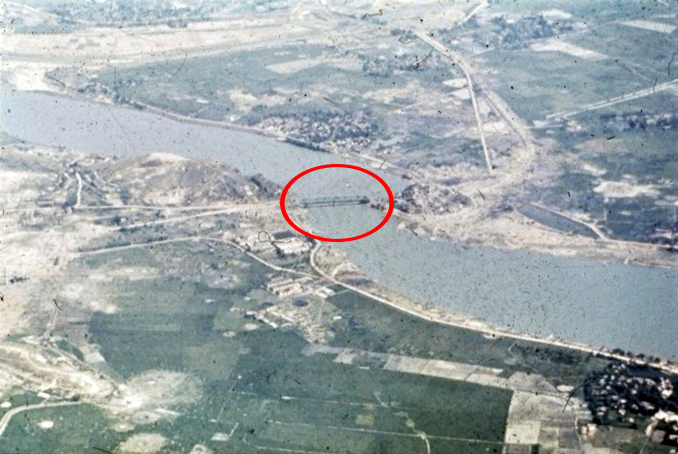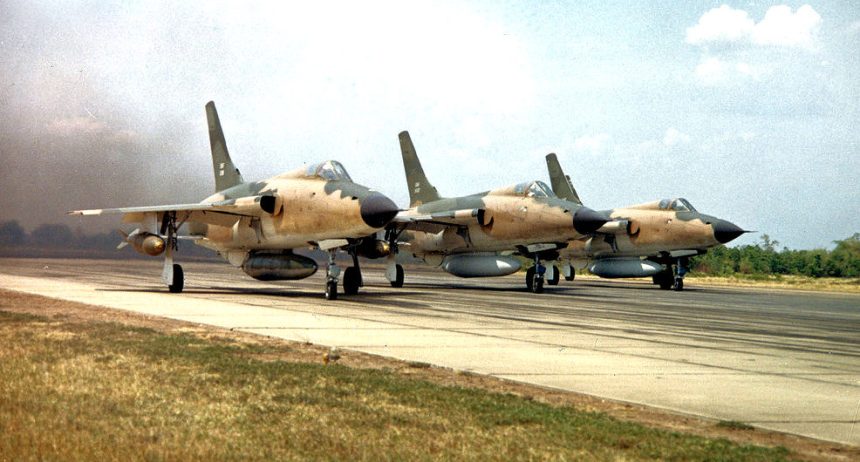4 April, 1965. Above Thanh Hóa, (then) North Vietnam.
It was like trying to hit a needle in a haystack, kill a fly with a sledgehammer, or whatever analogy you prefer for using brute force to apply surgical precision in the middle of a swirling ambush.
By analogy and history, the attack on Dragon’s Jaw is a bizarre mismatch of weapons to mission. It is another hard lesson for U.S. air power in the ‘60’s. Several decades of evolving doctrine and aircraft development have led the U.S. Air Force in a different direction from how air wars will actually be fought in the future. Instead of long range strategic nuclear attack, tactical precision anti-insurgent strike is the emerging mission. The U.S. will continue to learn that hard lesson on this day.
By any measure this is an impressive air armada: Sixty-six advanced supersonic fighters and strike aircraft from America’s “Century Series”. The main strike package is 46 Republic F-105 Thunderchiefs with massive bomb loads. The defensive escort is 21 North American F-100 Super Sabres holstering a covey of air-to-air missiles. The strike and escort fighters are supported by an enormous number of tanker, surveillance, rescue and reconnaissance planes. They all have one objective: to kill “The Dragon”.
The Dragon is the Thanh Hóa Bridge, near the geographic center of North Vietnam. The North Vietnamese nicknamed the bridge “Hàm Rồng” or “Dragon’s Jaw” since its massive steel and concrete construction seem like a row of sturdy teeth set in the mouth of a deadly dragon. The Dragon itself is made up of one of the most sophisticated integrated air defense networks on earth modeled closely after the most sophisticated, the Soviet Union’s.
Ironically, if this same task force had been attacking the Soviet Union with nuclear weapons their results would have almost certainly been better. That is the mission these aircraft were actually designed for. But the Dragon is a small, critical target, and an elusive one. Even though it’s not an all-out nuclear war with the Red Menace, the Dragon must be slayed in the ongoing proxy war that is Vietnam.
The Thanh Hóa Bridge would be a tough target to hit even without an advanced, integrated network of radar guided anti-aircraft guns, SAMs and MiGs surrounding it. The bridge has only a single one-meter wide railroad track on its deck. It is 540 feet long and 54 feet wide at its widest point. From the attack altitude of about 10,000 feet it is difficult to see well at high-speed.
The flight of F-105 Thunderchiefs break into sections of four aircraft each. Today they are armed with 750 pound “dumb” bombs. The day before a nearly identical strike also failed to destroy the Dragon’s Jaw when the Thunderchiefs attacked with crude AGM-12 Bullpup guided missiles and 750 pound dumb bombs. The AGM-12 missiles, an early attempt at “smart” weapons, failed significantly. Remarkably, even though some of the 750 pounders did hit the bridge, they had little effect. The first attempt at breaking the Dragon’s Jaw on April 3rd failed spectacularly. The bridge proved sturdier than expected, the weapons less precise than hoped.
Having abandoned the AGM-12 Bullpup missiles from the day before the F-105 Thunderchiefs would strike with only dumb bombs today.
The F-105 was originally designed to carry a nuclear weapon enclosed within its streamlined fuselage using an internal bomb bay. It was supposed to attack a target from low altitude at Mach 2, “toss” the nuclear weapon at the target in a pop-up attack, and escape at twice the speed of sound.
Today the big F-105 “Thuds” lug a junkyard of dumb bombs under their sleek swept wings and below their sinewy Coke-bottle curved fuselage. The yardsale of external bombs and bomb racks creates enormous drag on the needle-nosed “Thud”, slowing it to below supersonic speed and making it vulnerable.
As predictably as a firing line of advancing redcoat soldiers facing off against Native American insurgents in the Revolutionary War, the Thunderchiefs returned the very next day, marching across the aerial battlefield in broad daylight. The North Vietnamese had been ready the day before. Today they were angry, battle hardened and ready.
According to historical accounts ranging from Air Force Magazine to Wikipedia, four of eight lightweight, nimble, subsonic MiG-17s (NATO codename “Fresco”) of the North Vietnamese 921st “Sao Do” (Red Star) Fighter Regiment led by North Vietnamese flight leader Trần Hanh visually acquired an attack formation of four F-105Ds at 10:30 AM.
The Thunderchiefs were just starting to drop their bombs and already committed to their attack run. Flight leader Trần Hanh ordered his wingman, Pham Giay, to cover his attack on the F-105s. Hanh dove in through light cloud cover, achieving complete surprise. He opened fire on the F-105 with his heavy 37mm cannon at extremely close range, only 400 meters. Having attacked from above and behind in a classic ACM (Air Combat Maneuvering) scenario, Hanh preserved energy and positioning. The hapless F-105, piloted by USAF Major Frank E. Bennett of the 355th Tactical Fighter Wing, was pummeled by the MiG’s cannon shells. It erupted in a comet of plunging fire and hurtled downward toward the Gulf of Tonkin. Major Bennett did not survive.

A small, nimble, lightweight fighter had just gotten the better of a large, heavily loaded fighter-bomber despite having a substantial escort from F-100 Super Sabres. The Super Sabre fighter escort was out of position to respond to the MiG-17 ambush. A brutally hard lesson in the future of air combat was in session.
The melee continued when another North Vietnamese MiG-17 pilot reportedly named “Le Minh Huan” downed a second F-105D, this one piloted by USAF Capt. J. A. Magnusson. Capt. Magnusson reportedly radioed that he was heading for the Gulf of Tonkin after being hit. He struggled to maintain control of his heavily damaged Thunderchief as he tried to escape North Vietnam. Capt. Magnusson was forced to eject twenty miles from the island of Hon Me, and was eventually listed as missing in action, then killed in action after a 48-hour search turned up nothing.
Painfully, the U.S. Air Force confirmed they had lost two F-105s and pilots in the second attack on the Dragon’s Jaw. Even worse, the bridge remained intact, a straight, iron grin at the futile attack of the Americans.
After the failed F-105 strikes and aircraft losses the Americans were desperate to destroy the Dragon’s Jaw bridge. Author Walter J Boyne wrote in Air Force Magazine that the U.S. developed a bizarre, massive pancake-shaped bomb weighing two and a half tons and measuring eight feet in diameter but only thirty inches thick. The gigantic, explosive Frisbee was dropped from the back of a lumbering C-130 Hercules transport and was intended to float down river toward the bridge where it would be detonated by a magnetic fuse. Several of the weapons were actually dropped, one C-130 was lost.
The bridge remained intact.
Early laser guided bombs were also employed against the Dragon’s Jaw with modest success. An attack on May 13, 1972 by a flight of 14 F-4 Phantoms used early “smart” bombs and actually knocked the bridge surface off its pilings, briefly rendering it inoperable and forcing repairs.
But the bridge still stood.
Attacks on the Dragon’s Jaw continued until October 6, 1972. A flight of four Vought A-7 Corsair attack aircraft from the aircraft carrier USS America (CV-66) was finally successful in breaking the bridge in half. They used the AGM-62 Walleye guided bomb and 500-pound Mk.84 general purpose “dumb” bombs. The bridge was finally severed at its center piling.
Author Walter Boyne wrote about the final strike, “At long last, after seven years, 871 sorties, tremendous expenditure in lives, 11 lost aircraft, and a bewildering array of expended munitions, the Dragon’s Jaw was finally broken.”
The key lesson from the brutal campaign to destroy the Dragon’s Jaw was that tactics and equipment need to be adaptable and precise in the modern battlespace.

The F-105 Thunderchief was an impressive aircraft, but was forced into a brutal baptism of fire over Vietnam during an era when air combat was in transition. As a result, the F-105 suffered heavy losses. The history of the aircraft went on the include an unusual accident with the U.S. Air Force Flight Demonstration Team, The Thunderbirds. On May 9, 1964 Thunderbird Two, an F-105B piloted by USAF Captain Eugene J. Devlin, snapped in half during the pitch-up for landing at the old Hamilton Air Base in California. The Thunderchief only flew in six official flight demonstrations with the Thunderbirds.
Interestingly, and perhaps ominously, the U.S. Air Force’s F-35A Lightning II shares a remarkable number of similarities with the Republic F-105 Thunderchief used in the raid on the Dragon’s Jaw in 1965.
According to author Dr. Carlo Kopp, the F-35A dimensions are oddly similar to the F-105. But among several critical differences is the wing surface area, with the F-35A having larger wing surface area and the resultant lower wing loading than the F-105. Other major differences are the F-35A’s low observable technology and greatly advanced avionics, data collecting, processing and sharing capability. Finally, the F-35A is purpose-built for a wide range of mission sets, whereas the F-105 was predominantly a high-speed, low-level nuclear strike aircraft poorly suited for conventional strike.
Lessons learned from the F-105 strike on the Dragon’s Jaw, the success of the nimble, lightweight North Vietnamese MiG-17s and the need for better precision strike capability are now deeply ingrained in U.S. Air Force doctrine. But revisiting this story is a vital part of understanding the evolving mission of the air combat warfighter and the high cost of failing to adapt in the constantly evolving aerial battlespace.









